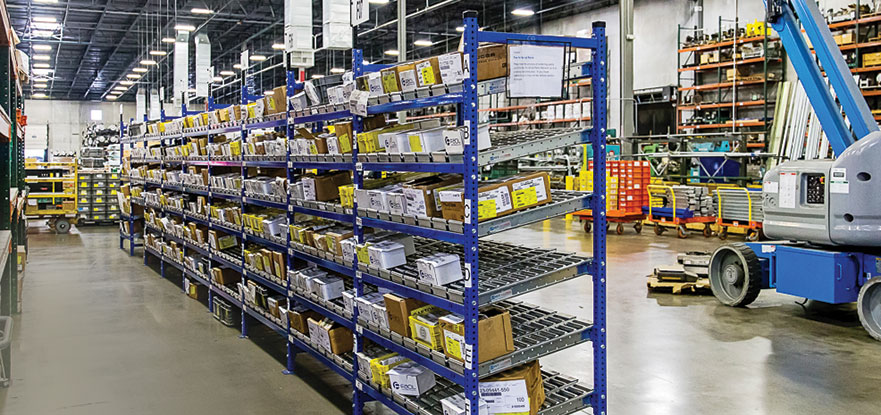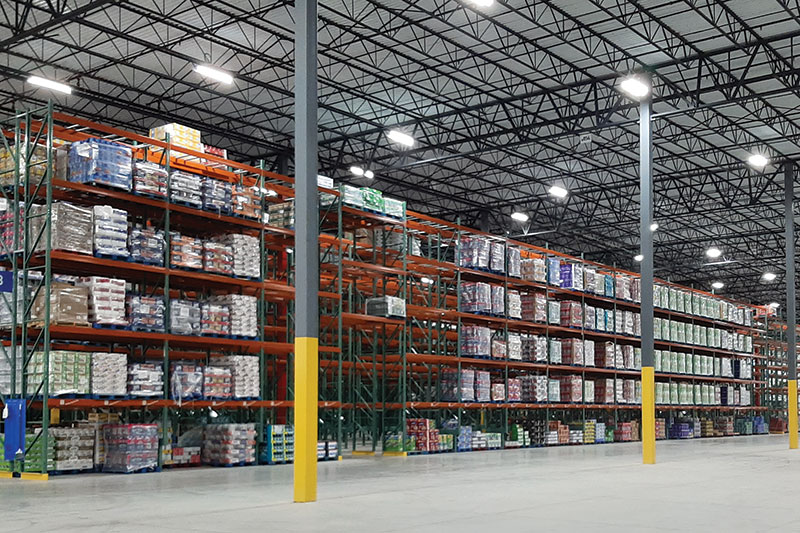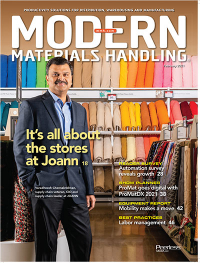A year of change for warehouse rack and shelving
Finding themselves in the throes of an e-commerce boom and behind the eight ball, more companies are rethinking their rack and shelving to make way for more SKUs while also adhering to workplace social distancing rules.
With the e-commerce boom in full swing, social distancing rules in effect at most workplaces, and warehouse space at a premium, more companies are paying attention to their fulfillment footprints and coming up with new ways to maximize those investments. As the storage structures that keep products moving fluidly through the world’s warehouses and DCs, rack and shelving helps maximize storage space, speeds up order throughput and enables social distancing.
The latter became a key priority for companies in 2020 as they scrambled to remake their physical locations into safe, Covid-free environments for onsite workers. “Equipment that can accommodate social distancing is a new requirement that’s grown substantially since Covid emerged,” says Chris Williams, director of national sales at Konstant. “Due to these demands, we’ve moved into some different social/physical distancing product lines that we didn’t previously have in our catalog.”
Williams says racking and shelving options that allow more space between workers as they fulfill orders, but also help enhance productivity and throughput, are in particularly high demand right now. Working with UNEX, Konstant has also been selling more picking carts and other pieces of equipment that allow individuals to work more independently on the warehouse or DC floor.
Many of these investments are being made in the name of grabbing a piece of the growing e-commerce pie, which increased by 40% in 2020—faster than it has in at least two decades. With online consumers expecting complete orders to be delivered to the homes within a day or two (max), the pressure has been on the fulfillment centers to deliver on these promises…and more.
“With the shift to increased e-commerce levels, more companies are thinking about how they can become more efficient at handling more SKUs, each picking and direct-to-consumer shipments,” says Jay Cox, director of sales at UNEX. “That’s the situation everyone is in right now, and it’s driving the way companies set up their fulfillment models.”
Navigating the new normal
As companies navigate these new demands, Cox says rack and shelving producers haven’t had to pivot too much to accommodate the changes. “We’ve always specialized in helping companies become more efficient with their picking processes, so that hasn’t changed,” says Cox. Even so, he says UNEX always has new ideas on the drawing board and is coming up with new designs meant to accommodate the needs of the modern customer.
In many cases, that means designing modular, flexible products that can be repositioned, sized and/or broken down into smaller structures. “We’re helping customers come up with new ideas and trying be more creative with the designs that we’re making for them,” says Cox, who notes that the company’s FlowCell modular flow racks can be built out a number of different ways to accommodate various application types and environments.
The manufacturer’s SpeedCell high-density storage racks are equally as flexible and allow companies to squeeze more SKUs into a smaller footprint. “To accommodate the uptick in e-commerce orders, companies have to be able to hold, store and pick more products using their existing space,” says Cox. “With the right racking and shelving in place, they can access additional, useable space without having to knock down walls or build new facilities.”

To accommodate the uptick in e-commerce orders, companies have to be able to hold, store and pick more products using their existing space.
A rollercoaster of a year
Reflecting on the events of 2020 and surveying the current fulfillment landscape, Williams says many companies have changed the way they operate as a result of the global pandemic, supply chain disruptions and e-commerce boom. In most cases, these shifts necessitate one or more changes to a company’s warehouse equipment—rack and shelving included.
That’s made life pretty busy these days for Konstant, which makes an array of storage solutions for warehouses and DCs. When a company shifts focus to e-commerce and takes the emphasis off direct-to-store orders, for example, it needs new (or, reorganized) shelving, rack and safety products to accommodate the changes. “We’re really busy helping them adapt to these shifts,” says Williams. “Our customers basically needed everything ‘done about six or eight months ago’ right now, and many of them are operating in reactive mode.”
This is particularly true of customers in the big box retail, grocery and e-commerce segments, Williams adds. “It been a rollercoaster of a busy year,” he says, referring both to 2020 and the first few weeks of 2021. Despite the fluctuations, he says customers aren’t asking for different products; they’re just asking for more of the products that Konstant already produces.
Distribution centers that were set up to ship pallet loads and truckloads of products to individual big box stores, for instance, are now modifying existing facilities to enable a higher volume of each and case picks for e-commerce distribution. “They’re picking and moving products in different quantities and using different methods than they did before,” Williams explains. “This has led to lot of changing and retrofitting of existing facilities to adapt to the new reality of their businesses.”
It’s also required some creativity on the part of the rack and shelving manufacturers, and particularly from the design and engineering standpoint. “Our goal is to effectively use what people already have and change the method in which they’re delivering or picking their products,” says Williams, who adds that manufacturers like Konstant have also had to improve their own nimbleness and agility as a result of these market shifts.
For example, it recently added live chat on its website to accommodate more customer service inquiries and has also expanded the size of its inside sales and customer service teams. Some of these shifts came as a result of the Covid-related shutdowns and the increase in remote work.
“Because we’re less customer-facing right now, quick responsiveness and online chat have both became more important,” says Williams, “particularly when it comes to our quick-ship products.” In many cases, those high-demand products relate in some way to e-commerce fulfillment and allow social distance between workers.
Preparing for what’s to come
At Ridg-U-Rak, Dave Olson, national sales manager, says the e-commerce boom has started to drive a shortage of warehouse and DC space in the United States.
According to CBRE Research, each $1 billion in incremental e-commerce sales generates demand for 1.25 million square feet of new warehouse space. Based on these numbers, it projects net absorption to reach nearly 250 million square feet in 2021, more than the previous five-year annual average of 211 million square feet. “This will spur new construction, which is already near record levels, and strong preleasing of speculative projects,” CBRE predicts.
Olson says the shortage may also push companies to rethink their physical fulfillment footprints and find new ways to leverage automation, vertical space, robotics, and rack and shelving systems without having to acquire or build new facilities.
Serving both industrial and retail customers with its static storage options, Ridg-U-Rak has been helping large organizations adopt racking solutions that can be easily set up and used without the need for much design or other hands-on processes—or that can be managed without having to have a materials handling consultant come onsite to do the work.
“We’re at a point where business travel is still at a minimum, so companies just aren’t providing the same design services to customers that they normally would be,” says Olson, who tells companies in need of rack and shelving support to find providers that are handling more of those processes virtually right now.
And, while it’s not always easy to get these projects handled sight unseen, many companies simply don’t have the luxury of waiting for the pandemic to end before they upgrade or add new warehouse space to their portfolios.
The “waiting game” may also be longer than usual, thanks to current business conditions. To companies that are either revamping their existing warehouse operations or adding new locations this year, Williams cautions that lead times may be longer than usual industry wide, mainly due to the persistent supply chain disruptions that continue to plague many business sectors.
“Manufacturers in general are busier than they’ve ever been, so planning ahead is critically important,” says Williams, who adds that building permits, installation teams, and other elements are also taking longer than usual to complete right now. “What may have been a two- or three-week project is now taking longer as a result of global supply chain issues,” he adds

Article Topics
Racks & Shelving News & Resources
Steele Solutions showcases advanced structural steel platforms and materials handling chutes Frazier shows Pallet Spacing System and Method Steel King Industries announces strategic collaboration with Automha Americas Nucor discusses future rack project Toyota Material Handling receives Manufacturing Excellence award for Community Impact Conventional warehousing update 60 Seconds With Kevin Curry, industry veteran More Racks & ShelvingLatest in Materials Handling
AutoStore to launch U.S. headquarters in greater Boston region Trew expanding manufacturing and development campus in southwest Ohio IFR: robot installations by U.S. manufacturing companies up 12 percent last year Geek+ and System Teknik deploy PopPick solution for pharmacy group Med24.dk Beckhoff USA opens new office in Austin, Texas Manhattan Associates selects TeamViewer as partner for warehouse vision picking ASME Foundation wins grant for technical workforce development More Materials HandlingAbout the Author
Subscribe to Materials Handling Magazine

Find out what the world's most innovative companies are doing to improve productivity in their plants and distribution centers.
Start your FREE subscription today.
April 2024 Modern Materials Handling

Latest Resources












